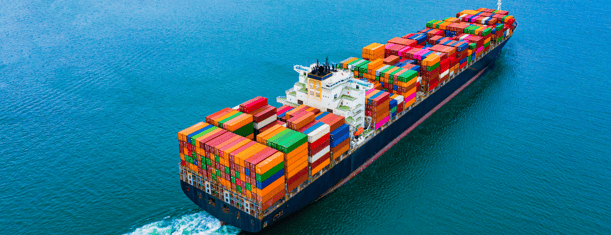Jump to a section
Navigating international shipping and customs can be a daunting task for e-commerce businesses; sending packages across borders, dealing with taxes and regulations, and ensuring proper packaging can be overwhelming. But, if you don’t offer international shipping, you’re missing out on a huge market.
International shipping is the process of sending goods from one country to another. For example, if you’re sending a parcel from the UK to Spain, this would be international shipping.
Expanding your e-commerce business’s reach to international markets opens up a world of opportunities. From accessing new customer bases to increasing your revenue streams, venturing into international shipping can provide substantial benefits for your e-commerce business. So, let’s delve into the key considerations, strategies, and best practices that will empower you to navigate international shipping and customs with confidence.
Research and select international shipping partners
One crucial aspect is researching and selecting reliable and cost-effective international shipping partners. Choosing the right shipping partner or partners is significant because they will be responsible for the safe and timely delivery of your packages to your customers.
When researching shipping carriers, there are several factors to consider:
Shipping rates: ensure they align with your budget. Look for carriers that offer competitive prices without compromising on service quality.
Delivery times: Efficient and reliable delivery is crucial for customer satisfaction.
Tracking capabilities: Tracking allows you and your customers to monitor the progress of shipments, providing peace of mind and transparency.
While researching shipping carriers, it's also essential to evaluate their reputation and customer reviews. Look for feedback from other e-commerce businesses or individuals who have used their services.
Some international couriers you could research include:
Royal Mail
Ship internationally with Royal Mail using these shipping methods:
-
International Tracked & Signed
-
International Tracked
-
International Signed
-
International Business Standard Priority
-
International Business Standard Economy
Evri
Evri, or Hermes as it was previously known, will ship your goods internationally using its:
-
Evri International
Parcelforce Worldwide
Parcelforce Worldwide offers the following services from the UK:
-
Global express
-
Ireland express
-
Global priority
-
Global value
-
Global economy
-
HM Forces
DPD
Send your business’ parcels internationally using:
-
DPD Classic
-
DPD Express
-
Air Classic
-
DPD Direct
-
DPD Priority international mail
-
DPD Standard international mail
FedEx
You can send your parcels via FedEx using:
-
FedEx Europe First
-
FedEx International First
-
FedEx International Priority
-
FedEx International Priority Express
-
FedEx International Connect Plus
-
FedEx International Priority Freight
-
FedEx International Economy
-
FedEx International Economy Freight
By conducting thorough research, you can find shipping partners that meet your requirements and ensure a smooth international shipping process.
Understand international shipping documentation
International shipping involves various documentation requirements that must be fulfilled for smooth customs clearance. Some of the essential shipping documents include commercial invoices, packing lists, and certificates of origin.
-
A commercial invoice is a document that provides details about the goods being shipped, including their value, quantity, and description. It serves as proof of the transaction and helps customs authorities assess the applicable duties and taxes. The information needed on a commercial invoice includes:
-
Your business and customer’s names and addresses
-
The price, descriptions, and quantity of the products included
-
How the sale was made and the terms of the payment
-
Shipping method
-
A packing list provides a detailed inventory of the contents in each shipment. It helps customs officers verify the accuracy of the declared goods and ensures compliance with regulations. The information needed on a packing list includes:
-
Contents information
-
Weight and dimensions of the package
-
The type and quantity of packages
-
Certificates of origin are documents that certify the country in which the goods were produced or manufactured. These certificates may be required to determine eligibility for trade agreements or to assess the appropriate duties and taxes. A certificate of origin is always needed when sending goods outside the EU.
Accurate and properly prepared shipping documentation is crucial for successful customs clearance. Ensure that you understand the purpose and importance of each document and complete them accurately. Mistakes or missing information can lead to delays and additional costs. Consider seeking professional assistance or consulting with customs experts to ensure compliance with documentation requirements.
Tariffs, duties and taxes
When you send items abroad, the goods you ship are given a classification code that corresponds to the items they are.
These codes play a crucial role in determining the duties and taxes applicable to either you or your customer for shipping, delivery, and receiving of goods.
It’s important that you accurately select the correct code for each item shipped internationally to avoid unexpected customs procedures or documentation requirements. Failure to comply with these regulations can result in customs withholding or destroying the package if the necessary documentation is not submitted within the specified timeframe or if either party refuses to cover the charges.
Customs compliance and regulatory requirements
Compliance with customs regulations is of utmost importance when shipping internationally. Failure to comply can result in delays, fines, or even the seizure of your shipments. Familiarise yourself with the customs regulations of the countries you plan to ship to and understand the specific requirements and restrictions.
Start by visiting the official customs website for the countries you'd like to ship to and take a look at the prohibited and restricted items. Some products, such as plants, seeds, alcoholic beverages, or food products, may face additional scrutiny or be outright prohibited. Research any specific import/export licences or permits required for certain product categories.
It's also important to stay informed about trade agreements and preferential tariff programs that may apply to your products. These agreements can offer reduced or eliminated duties for eligible shipments, allowing you to take advantage of trade benefits and remain competitive in the global market.
By thoroughly researching and complying with customs regulations, you can ensure a smoother shipping process and minimise the risk of complications or delays.
Tracking and customer communication
Once you've shipped your packages internationally, effective tracking and customer communication become vital. Providing customers with tracking numbers and regular shipment updates helps build trust and improves the overall customer experience.
That’s why it’s important to choose a shipping carrier that offers reliable tracking services. This allows you to monitor the progress of the shipment from dispatch to delivery.
Even better, share tracking numbers with customers promptly, such as in the dispatch confirmation email to ensure that they can easily access tracking information without having to contact your customer support channels.
What to charge for international shipping
This is one of the most important parts of your overseas shipping strategy - price it too high and you’re likely to see high cart abandonment rates at the checkout, price it too low and your business will be out of pocket. When considering your shipping charges, you should take into account:
Packaging
You might require various sizes of boxes or envelopes to accommodate different sized shipments. It's possible that you'll also need cushioning materials like bubble wrap or stuffing depending on what you ship. You can purchase your packaging supplies online, visit the post office, or office supply stores.
Incorporating the cost of packaging into your overall product cost should be relatively straightforward. Depending on the size and quality, most packaging materials should cost somewhere between £1 to £5 each.
Cost of shipping
This is the actual price of using a courier to ship the goods to your customer. Once you’ve decided which courier and service to use, factor this into the overall cost.
Insurance
The longer the distance your package is being shipped, the more opportunities for it to get lost, broken, or damaged. Getting shipping insurance might be worth considering if you’re going to ship high value goods. If you take out shipping insurance, the overall cost should be factored into your international shipping fee.
Duties and taxes
When the value of a shipment is above the tax threshold for a country, duties will apply. There are two ways to pay for duties:
-
Delivery Duty Unpaid (DDU): Duty is not included in the shipping cost and must be paid for when the item arrives at the destination port.
-
Delivery Duty Paid (DDP): Duty is included in the shipping cost at checkout, and has already been paid for by the customer before the item arrives at the destination port.
The bottom line
In conclusion, navigating international shipping and customs is a crucial step for e-commerce businesses looking to expand their reach and tap into global markets. By thoroughly researching and selecting reliable shipping partners, understanding documentation requirements, managing tariffs and taxes, complying with customs regulations, and effectively communicating with customers, you can navigate the complexities of international shipping with confidence.
Why not use your Capital on Tap Business Credit Card to embrace the potential of international shipping, and unlock the growth and profitability that awaits you.
This does not constitute financial advice. If you want to understand international shipping and customs in detail, you should speak to your financial advisor or accountant.











